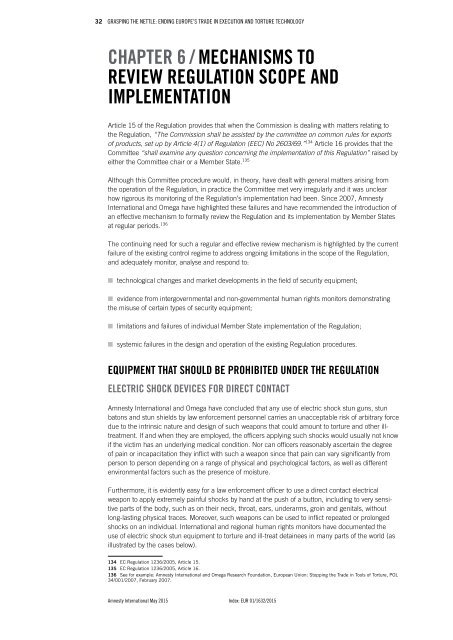Grasping the nettle
1Gsbbd6
1Gsbbd6
You also want an ePaper? Increase the reach of your titles
YUMPU automatically turns print PDFs into web optimized ePapers that Google loves.
32 <strong>Grasping</strong> <strong>the</strong> <strong>nettle</strong>: Ending Europe’s Trade in Execution and Torture Technology<br />
Chapter 6 / Mechanisms to<br />
review Regulation scope and<br />
implementation<br />
Article 15 of <strong>the</strong> Regulation provides that when <strong>the</strong> Commission is dealing with matters relating to<br />
<strong>the</strong> Regulation, “The Commission shall be assisted by <strong>the</strong> committee on common rules for exports<br />
of products, set up by Article 4(1) of Regulation (EEC) No 2603/69.” 134 Article 16 provides that <strong>the</strong><br />
Committee “shall examine any question concerning <strong>the</strong> implementation of this Regulation” raised by<br />
ei<strong>the</strong>r <strong>the</strong> Committee chair or a Member State. 135<br />
Although this Committee procedure would, in <strong>the</strong>ory, have dealt with general matters arising from<br />
<strong>the</strong> operation of <strong>the</strong> Regulation, in practice <strong>the</strong> Committee met very irregularly and it was unclear<br />
how rigorous its monitoring of <strong>the</strong> Regulation’s implementation had been. Since 2007, Amnesty<br />
International and Omega have highlighted <strong>the</strong>se failures and have recommended <strong>the</strong> introduction of<br />
an effective mechanism to formally review <strong>the</strong> Regulation and its implementation by Member States<br />
at regular periods. 136<br />
The continuing need for such a regular and effective review mechanism is highlighted by <strong>the</strong> current<br />
failure of <strong>the</strong> existing control regime to address ongoing limitations in <strong>the</strong> scope of <strong>the</strong> Regulation,<br />
and adequately monitor, analyse and respond to:<br />
n technological changes and market developments in <strong>the</strong> field of security equipment;<br />
n evidence from intergovernmental and non-governmental human rights monitors demonstrating<br />
<strong>the</strong> misuse of certain types of security equipment;<br />
n limitations and failures of individual Member State implementation of <strong>the</strong> Regulation;<br />
n systemic failures in <strong>the</strong> design and operation of <strong>the</strong> existing Regulation procedures.<br />
Equipment that should be prohibited under <strong>the</strong> Regulation<br />
Electric shock devices for direct contact<br />
Amnesty International and Omega have concluded that any use of electric shock stun guns, stun<br />
batons and stun shields by law enforcement personnel carries an unacceptable risk of arbitrary force<br />
due to <strong>the</strong> intrinsic nature and design of such weapons that could amount to torture and o<strong>the</strong>r illtreatment.<br />
If and when <strong>the</strong>y are employed, <strong>the</strong> officers applying such shocks would usually not know<br />
if <strong>the</strong> victim has an underlying medical condition. Nor can officers reasonably ascertain <strong>the</strong> degree<br />
of pain or incapacitation <strong>the</strong>y inflict with such a weapon since that pain can vary significantly from<br />
person to person depending on a range of physical and psychological factors, as well as different<br />
environmental factors such as <strong>the</strong> presence of moisture.<br />
Fur<strong>the</strong>rmore, it is evidently easy for a law enforcement officer to use a direct contact electrical<br />
weapon to apply extremely painful shocks by hand at <strong>the</strong> push of a button, including to very sensitive<br />
parts of <strong>the</strong> body, such as on <strong>the</strong>ir neck, throat, ears, underarms, groin and genitals, without<br />
long-lasting physical traces. Moreover, such weapons can be used to inflict repeated or prolonged<br />
shocks on an individual. International and regional human rights monitors have documented <strong>the</strong><br />
use of electric shock stun equipment to torture and ill-treat detainees in many parts of <strong>the</strong> world (as<br />
illustrated by <strong>the</strong> cases below).<br />
134 EC Regulation 1236/2005, Article 15.<br />
135 EC Regulation 1236/2005, Article 16.<br />
136 See for example: Amnesty International and Omega Research Foundation, European Union: Stopping <strong>the</strong> Trade in Tools of Torture, POL<br />
34/001/2007, February 2007.<br />
Amnesty International May 2015 Index: EUR 01/1632/2015


